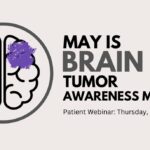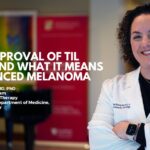
Published: April 10, 2021, Kristi Rosa in Targeted Oncology
In patients with metastatic uveal melanoma, frontline treatment with tebentafusp achieved significant and clinically meaningful improvement in overall survival, according to data from the phase 3 IMCgp100-202 trial.
In patients with metastatic uveal melanoma, frontline treatment with tebentafusp (IMCgp100) achieved significant and clinically meaningful improvement in overall survival (OS), according to data from the phase 3 IMCgp100-202 trial (NCT03070392) presented during a press briefing ahead of the virtual AACR Annual Meeting 2021.1
At a median follow-up of 14.1 months, the median OS with tebentafusp was 21.7 months (95% CI, 18.6-23.6) vs 16.0 months (95% CI, 9.7-19.4) with investigator’s choice of pembrolizumab (Keytruda), ipilimumab (Yervoy), or dacarbazine (stratified hazard ratio [HR], 0.51; 95% CI, 0.37-0.71; P <.0001). The 1-year OS rates in the investigative and control arms were 73.2% and 58.5%, respectively.
“[Tebentafusp] is the first investigational therapy in a phase 3 trial to improve OS in metastatic uveal melanoma, and this benefit was even seen in patients without RECIST objective response,” Jessica C. Hassel, MD, of the University Hospital Heidelberg in Germany, said in a presentation on the data. “We found a predictable and manageable safety profile, which was consistent with the mechanism of action of tebentafusp. Therefore, [the agent] has the potential to be practice-changing in uveal melanoma.”
Uveal melanoma is a rare disease with a low mutational burden and a poor prognosis. Approximately half of these patients will develop metastases in the liver, according to Hassel. Only few patients will derive benefit from immunotherapy agents, and no standard-of-care options are available to those who have metastatic disease. In frontline trials that have been done in patients with this disease, the 1-year OS rate has been about 50%.
Patients with uveal melanoma commonly express the melanocytic protein gp100, Hassel noted. Tebentafusp is a bispecific protein that is comprised of a soluble T-cell receptor that is fused to an anti-CD3 immune-effector domain and is designed to target gp100.
The phase 3 IMCgp100-202 trial enrolled 378 patients with previously untreated uveal melanoma. To be eligible for enrollment, patients had to be at least 18 years of age, have histologically or cytologically confirmed metastatic uveal melanoma, be HLA A*0201 positive per central assay, have an ECOG performance status of 0 or 1, and measurable or non-measurable disease per RECIST v1.1 criteria.2 Patients could not have previously received systemic treatment in the advanced setting, nor could they have received liver-directed therapy with the exception of surgery. Any lactate dehydrogenase level (LDH) was permitted.
Participants were randomized in a 2:1 fashion. Those enrolled to the investigative arm received tebentafusp at 20 mcg on day 1 of cycle 1, followed by 30 mcg on day 8 or cycle 1, and then 68 mcg day 15+ of cycle 1. Those in the control arm received either pembrolizumab at 2 mg/kg every 3 weeks, ipilimumab at 3 mg/kg every 3 weeks, or dacarbazine at 1000 mg/me every 3 weeks. Patients were stratified by LDH (greater than the upper limit of normal [ULN] vs ULN or less).
The co-primary end points of the trial were OS in patients randomized to tebentafusp vs investigator’s choice of treatment in the intent-to-treat population and OS in patents randomized to tebentafusp with rash during week 1 vs investigator’s choice of treatment. Key secondary end points included objective response rate and progression-free survival per investigator assessment.
“[When looking at] the Kaplan Meier curves for the primary end point of OS, you see an early and continuous separation for patients receiving tebentafusp vs investigator’s choice. Of note, most patients in the investigator’s choice arm received pembrolizumab,” Hassel noted when speaking to the efficacy data. “The OS benefit can be seen through all subgroups assessed. Patients with a lower tumor load who had a normal LDH always had a better HR vs those with a higher tumor load.”
The HR between the arms in those with an LDH at the ULN or below was 0.35 (95% CI, 0.21-0.60) vs 0.70 (95% CI, 0.46-1.09) in those with LDH that was greater than the ULN.
Regarding safety, toxicities with tebentafusp proved to be consistent with the proposed mechanism of action of the agent. Almost all, or 99.6% of patients, experienced any-grade adverse effects (AEs); 45% of patients had grade 3/4 effects.
The most frequent any-grade cytokine-mediated AEs reported with tebentafusp was cytokine release syndrome (CRS; 89%), pyrexia (76%), chills (47%), nausea (43%), fatigue (41%), and hypotension (38%). Among those who experienced cytokine-mediated toxicities that were grade 3/4 in severity, 4% had pyrexia, 3% had fatigue, and 3% had hypotension.
Eighty-three percent of patients experienced rash with the agent, while 69% reported pruritus, 29% had dry skin, and 23% had erythema. Eighteen percent of patients had grade 3/4 rash, while 5% had grade 3/4 pruritus.
“Very few severe cases of CRS [were reported]; it only occurred in 2 patients and both continued treatment,” Hassel noted. “The discontinuation rate was, in general, very low in the tebentafusp arm vs the investigator’s choice arm, at 2% vs 4%, [respectively].”
The majority of these AEs occurred within the first few weeks of treatment. Then, they decreased in frequency and severity, Hassel added. Notably, no tebentafusp-related deaths were reported per investigator assessment.
“This study has several firsts,” Antoni Ribas, MD, a professor of medicine, professor of surgery, and professor of molecular and medical pharmacology at the University of California Los Angeles and director of the Tumor Immunology Program at the Jonsson Comprehensive Cancer Center, commented during the briefing. “It’s the first-ever clinical trial improving OS in patients with uveal melanoma. It’s the first T-cell receptor therapeutic that has been successfully developed and it’s the first therapeutic that’s targeting a melanocytic antigen that has shown an improvement in a randomized trial. I think it’s a practice-changing study and we hope to be able to use this in the clinic.”
Tebentafusp has been granted a fast track designation and an orphan drug designation from the FDA, along with a Promising Innovative Medicine designation under UK Early Access to Medicines Scheme.
Referencias:
1. Piperno-Neumann S, Hassel JC, Rutkowski P, et al. Phase 3 randomized trial compared tebentafusp with investigator’s choice in first line metastatic uveal melanoma. Presented at: AACR Annual Meeting 2021; April 10-15, 2021; Virtual. CT002.
2. Immunocore’s tebentafusp demonstrates superior overall survival compared to investigator’s choice in a phase 3 clinical trial of patients with previously untreated metastatic uveal melanoma. News release. Immunocore. November 23, 2020. Accessed April 9, 2021. https://bit.ly/33akuO0
Entradas recientes

Navigating the Journey Together – Conversations with Melanoma Caregivers

May is Brain Tumor Awareness Month

President’s Letter | April 2024

Celebrating a Milestone: 20 Years of the Dallas Steps Against Melanoma Walk

